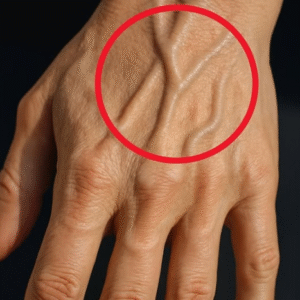“If Your Veins Are Visible, This Could Be Happening to Your Health”
Visible veins are often dismissed as a minor cosmetic concern, but they can sometimes signal underlying health conditions that warrant attention. While many people develop prominent veins naturally due to genetics, age, or body composition, changes in vein visibility can also be a sign of circulatory issues or other medical concerns. Understanding why veins become more noticeable and what it might indicate about overall health is crucial for proactive self-care.
Why Veins Become Visible
Veins carry blood back to the heart, and their visibility depends on several factors. For some individuals, veins are naturally closer to the skin’s surface, making them more apparent. Other contributing factors include:
-
Genetics – Family history plays a significant role. People with thin skin or fair complexions often have veins that are easier to see.
-
Low Body Fat – Less subcutaneous fat can make veins stand out. Athletes and individuals with lean builds frequently notice prominent veins, particularly in the arms and legs.
-
Age – As skin loses elasticity and thins with age, veins can become more prominent.
-
Temperature – Heat causes veins to dilate, making them more visible. Exercise and high temperatures can temporarily accentuate veins.
-
Hormonal Changes – Hormones affect vein health, and conditions like pregnancy can increase vein visibility due to increased blood volume and hormonal shifts.
While these factors are generally harmless, sudden or significant changes in vein visibility should be examined, as they may indicate underlying health issues.
Possible Health Implications
1. Varicose Veins
One of the most common medical causes of prominent veins is varicose veins. These occur when the valves in the veins become weak or damaged, leading to blood pooling and vein enlargement. Varicose veins are typically found in the legs and may cause:
-
Pain or aching
-
Swelling
-
Itching or burning sensation
-
Skin discoloration
While varicose veins are often a cosmetic concern, they can sometimes lead to more serious complications like blood clots or ulcers if left untreated. Risk factors include prolonged standing, obesity, pregnancy, and family history.
2. Venous Insufficiency
Chronic venous insufficiency occurs when the veins have trouble sending blood from the limbs back to the heart. It can lead to swelling, skin changes, and visible veins. Symptoms may include:
-
Heaviness or fatigue in the legs
-
Swelling around the ankles
-
Pain that worsens after long periods of standing or sitting
Lifestyle changes, such as elevating the legs, wearing compression stockings, and regular exercise, can help manage venous insufficiency. Severe cases may require medical interventions.
3. Blood Clots (Deep Vein Thrombosis)
While less common, sudden swelling or increased vein visibility could indicate a blood clot in the deep veins, known as deep vein thrombosis (DVT). DVT is a serious condition that requires immediate medical attention. Warning signs include:
-
Swelling in one leg
-
Pain or tenderness, often in the calf
-
Red or discolored skin
-
Warmth in the affected area
DVT can lead to life-threatening complications if the clot travels to the lungs, causing a pulmonary embolism. Recognizing symptoms early is crucial.
4. Heart and Circulatory Conditions
Prominent veins may sometimes reflect underlying circulatory or heart-related issues. When veins appear engorged or blue, it could signal poor circulation, increased pressure in the veins, or heart problems affecting blood flow. Symptoms that accompany visible veins, such as fatigue, shortness of breath, or chest pain, should prompt immediate medical evaluation.
5. Hormonal or Lifestyle Factors
Certain lifestyle choices and hormonal shifts can also affect vein appearance. Factors include:
-
Exercise – Intense workouts can cause veins to temporarily bulge.
-
Pregnancy – Increased blood volume and hormonal changes can make veins more noticeable.
-
Weight fluctuations – Rapid weight loss can reduce the fat layer under the skin, revealing veins.
While these causes are generally benign, monitoring for any sudden changes or associated symptoms is recommended.
Preventing and Managing Visible Veins
Even when visible veins are not indicative of a serious condition, maintaining healthy vein function is important. Strategies include:
-
Regular Exercise – Improves circulation and strengthens vein walls. Walking, swimming, and cycling are particularly effective.
-
Healthy Weight Management – Excess weight puts additional pressure on veins, particularly in the legs.
-
Elevating Legs – Reduces swelling and helps blood return to the heart.
-
Avoid Prolonged Sitting or Standing – Move around frequently to prevent blood pooling.
-
Compression Stockings – Can reduce swelling and improve circulation in the legs.
-
Hydration and Diet – Adequate water intake and a diet rich in fiber help maintain vascular health.
Medical treatments are also available for more severe cases. Procedures such as sclerotherapy, laser therapy, and vein stripping can address varicose veins and chronic venous insufficiency.
When to See a Doctor
While many cases of visible veins are harmless, certain signs warrant medical attention:
-
Sudden swelling or pain in the legs
-
Blue or discolored veins
-
Open sores or skin ulcers near visible veins
-
Rapid changes in vein appearance
-
Accompanying symptoms like shortness of breath, chest pain, or fatigue
Consulting a vascular specialist or primary care physician can help identify the cause and prevent potential complications. Early intervention often leads to better outcomes and reduces long-term risks.
Final Thoughts
Visible veins are not always a cause for concern, but they can sometimes signal important health issues. Understanding the difference between benign factors, such as genetics and exercise, versus signs of circulatory problems is key to maintaining overall well-being.
By monitoring changes, adopting a vein-friendly lifestyle, and seeking medical advice when needed, individuals can support healthy circulation and reduce the risk of complications. Whether it’s through exercise, diet, or medical intervention, maintaining vascular health is an essential component of overall wellness.
Ultimately, noticing your veins isn’t just a cosmetic observation—it can be an important clue about your body’s circulatory health. Paying attention to these signals and responding appropriately ensures that your veins—and your health—remain in the best possible condition.


